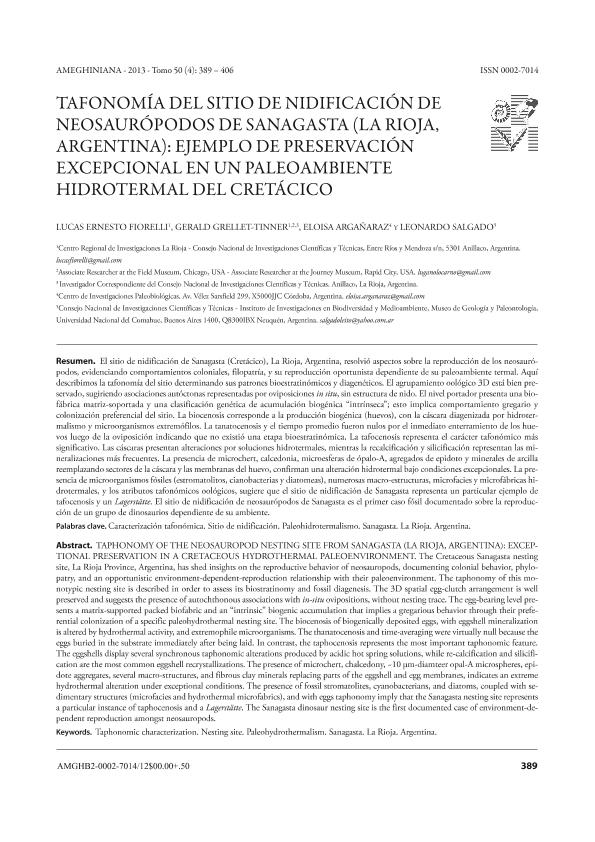Artículo
El sitio de nidificación de Sanagasta (Cretácico), La Rioja, Argentina, resolvió aspectos sobre la reproducción de los neosaurópodos, evidenciando comportamientos coloniales, filopatría, y su reproducción oportunista dependiente de su paleoambiente termal. Aquí describimos la tafonomía del sitio determinando sus patrones bioestratinómicos y diagenéticos. El agrupamiento oológico 3D está bien preservado, sugiriendo asociaciones autóctonas representadas por oviposiciones in situ, sin estructura de nido. El nivel portador presenta una biofábrica matriz-soportada y una clasificación genética de acumulación biogénica “intrínseca”; esto implica comportamiento gregario y colonización preferencial del sitio. La biocenosis corresponde a la producción biogénica (huevos), con la cáscara diagenizada por hidrotermalismo y microorganismos extremófilos. La tanatocenosis y el tiempo promedio fueron nulos por el inmediato enterramiento de los huevos luego de la oviposición indicando que no existió una etapa bioestratinómica. La tafocenosis representa el carácter tafonómico más significativo. Las cáscaras presentan alteraciones por soluciones hidrotermales, mientras la recalcificación y silicificación representan las mineralizaciones más frecuentes. La presencia de microchert, calcedonia, microesferas de ópalo-A, agregados de epidoto y minerales de arcilla reemplazando sectores de la cáscara y las membranas del huevo, confirman una alteración hidrotermal bajo condiciones excepcionales. La presencia de microorganismos fósiles (estromatolitos, cianobacterias y diatomeas), numerosas macro-estructuras, microfacies y microfábricas hidrotermales, y los atributos tafonómicos oológicos, sugiere que el sitio de nidificación de Sanagasta representa un particular ejemplo de tafocenosis y un Lagerstätte. El sitio de nidificación de neosaurópodos de Sanagasta es el primer caso fósil documentado sobre la reproducción de un grupo de dinosaurios dependiente de su ambiente. The Cretaceous Sanagasta nesting site, La Rioja Province, Argentina, has shed insights on the reproductive behavior of neosauropods, documenting colonial behavior, phylopatry, and an opportunistic environment-dependent-reproduction relationship with their paleoenvironment. The taphonomy of this monotypic nesting site is described in order to assess its biostratinomy and fossil diagenesis. The 3D spatial egg-clutch arrangement is well preserved and suggests the presence of autochthonous associations with in-situ ovipositions, without nesting trace. The egg-bearing level presents a matrix-supported packed biofabric and an “intrinsic” biogenic accumulation that implies a gregarious behavior through their preferential colonization of a specific paleohydrothermal nesting site. The biocenosis of biogenically deposited eggs, with eggshell mineralization is altered by hydrothermal activity, and extremophile microorganisms. The thanatocenosis and time-averaging were virtually null because the eggs buried in the substrate immediately after being laid. In contrast, the taphocenosis represents the most important taphonomic feature. The eggshells display several synchronous taphonomic alterations produced by acidic hot spring solutions, while re-calcification and silicification are the most common eggshell recrystallizations. The presence of microchert, chalcedony, ~10 μm-diamteer opal-A microspheres, epidote aggregates, several macro-structures, and fibrous clay minerals replacing parts of the eggshell and egg membranes, indicates an extreme hydrothermal alteration under exceptional conditions. The presence of fossil stromatolites, cyanobacterians, and diatoms, coupled with sedimentary tructures (microfacies and hydrothermal microfabrics), and with eggs taphonomy imply that the Sanagasta nesting site represents a particular instance of taphocenosis and a Lagerstätte. The Sanagasta dinosaur nesting site is the first documented case of environment-dependent reproduction amongst neosauropods.
Tafonomía del sitio de nidificación de neosaurópodos de Sanagasta (La Rioja, Argentina): ejemplo de preservación excepcional en un paleoambiente hidrotermal del Cretácico
Título:
Taphonomy of the neosauropod nesting site from Sanagasta (La Rioja, Argentina): exceptional preservation in a Cretaceous hydrothermal paleoenvironment
Fecha de publicación:
06/2013
Editorial:
Asociación Paleontológica Argentina
Revista:
Ameghiniana
ISSN:
0002-7014
e-ISSN:
1851-8044
Idioma:
Español
Tipo de recurso:
Artículo publicado
Clasificación temática:
Resumen
Archivos asociados
Licencia
Identificadores
Colecciones
Articulos(CCT - PATAGONIA NORTE)
Articulos de CTRO.CIENTIFICO TECNOL.CONICET - PATAGONIA NORTE
Articulos de CTRO.CIENTIFICO TECNOL.CONICET - PATAGONIA NORTE
Articulos(CRILAR)
Articulos de CENTRO REGIONAL DE INV. CIENTIFICAS Y TRANSFERENCIA TECNOLOGICA DE ANILLACO
Articulos de CENTRO REGIONAL DE INV. CIENTIFICAS Y TRANSFERENCIA TECNOLOGICA DE ANILLACO
Articulos(IANIGLA)
Articulos de INST. ARG. DE NIVOLOGIA, GLACIOLOGIA Y CS. AMBIENT
Articulos de INST. ARG. DE NIVOLOGIA, GLACIOLOGIA Y CS. AMBIENT
Citación
Fiorelli, Lucas Ernesto; Grellet-tinner, Gerald; Argañaraz, Eloisa; Salgado, Leonardo; Tafonomía del sitio de nidificación de neosaurópodos de Sanagasta (La Rioja, Argentina): ejemplo de preservación excepcional en un paleoambiente hidrotermal del Cretácico; Asociación Paleontológica Argentina; Ameghiniana; 2013; 4; 6-2013; 389-406
Compartir




